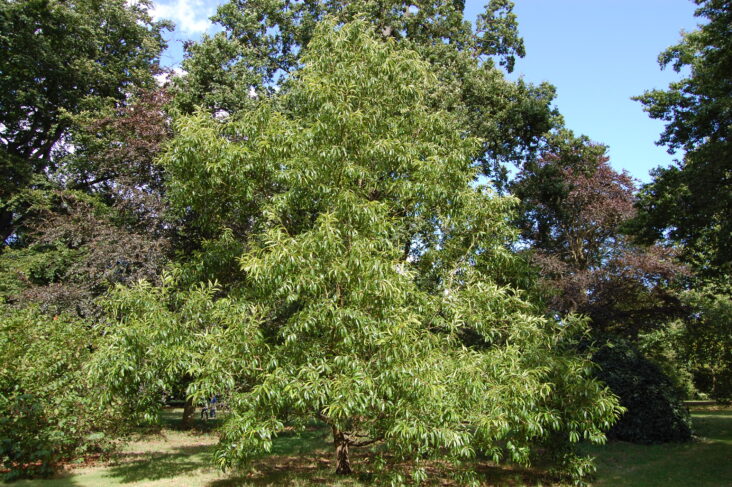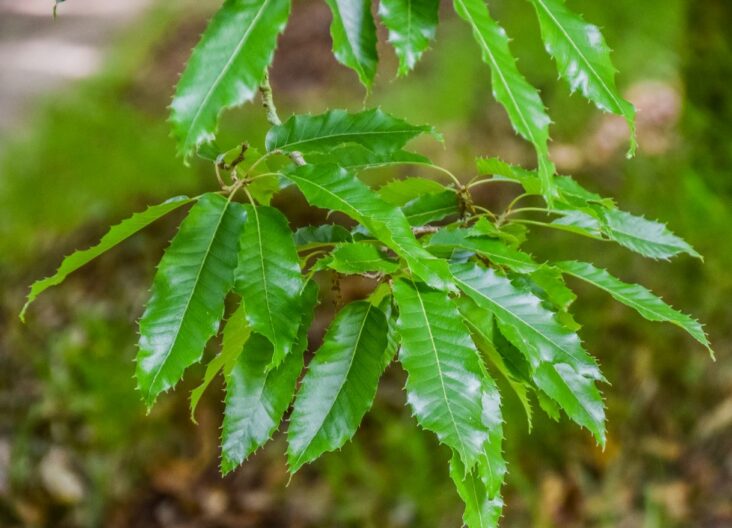The Sawtooth Oak is a famous shade tree that can survive a variety of climates and regions, including hardiness zones 5 through 9.
In the springtime, the leaves will put on a display of colors ranging from yellow to a golden yellow color. In the summer season, they will display a bright green color, and then they will change again in the fall to golden brown and orange. It’s extremely popular as a shade tree for its long reach.
You can expect this tree to grow swiftly, reaching an average height of 40 feet – 60 feet. The Sawtooth Oak grows at a reasonably quick rate between 12 to 24 inches a year until it reaches full maturity. For the plant’s success, it is encouraged to grow this tree in an area where it will receive at least six straight hours of sunlight.
Now, while this tree has some drought tolerance, it needs its fair share of water. Don’t let the ground stay dry for too long if you have to at all. It’s most successful in loamy, acidic, well-drained, sandy, and clay soils.

You don’t have to worry too much about the plant stressing out; the Sawtooth Oak transplants very easily. It will develop oblong bristle-like leaves as it matures, which can grow up to 7 1/2 inches long at maturity.
Expect the Sawtooth Oak to develop acorns that are about 1 inch in length, and also expect to see a great deal of activity with wildlife like squirrels, wild turkeys, and birds. Other than that, the sap often flows and that attracts all kinds of beetles who prefer this juicy nectar.
As it grows, it will start in the shape of a pyramid, but it will round out as it develops. In 1862 this tree was introduced to America but was native to Japan, China, Korea, and the Himalayan mountain range. This tree is often planted in North America and although it can be seen in Europe as well, it is not the most common sight.
The trees grow quite quickly and they are often planted for wildlife and to balance out the wooded areas. Despite that, the acorns are bitter compared to some other trees and they aren’t as utilized by the animals who feed on these.

The name Sawtooth comes from the saw-like edge on the leaves of the Quercus Acutissima. This tree will make a lovely addition to a part of your property that will benefit the most from shade and interaction with wildlife.
The sawtooth oak stands fifty to seventy feet in height and has a spread of 30-40 feet wide. It produces very well rounded acorns and they ripen in mid-spring and are mature on the oak trees near the end of summer. They are also one of squirrels and chipmunk’s favorite foods. They also store them back for winter months in tree trunks and holes in trees, dens, and caves. They also bury then for safekeeping to eat during those long winter months.
Sawtooth oak tres are stable and sturdy having a lifespan much longer than most humans. When timber loggers and tree cutters harvest oak trees for making oak lumber and flooring, the old wives take says the can count the rings inside the cut tree’s trunk and for every ring, it’s a year in age.
The American Horticulture Society claims that some oak trees live over 160 years. They are by far the most sturdy and stable tree know to man. Sawtooth oak trees originate in Asia and can not be eaten by humans because of their intense bitterness. It also has leaves that are 4-6 inches in length and pointed ends like teeth on the ends. This is where the tree gets it’s name “sawtooth oak” from.

Homeowner’s usually desired oak trees because they are not only hardy but they can withstand drought and their roots go straight down in the soil so they never destroy lawnmower blades or disturb concrete sidewalks or driveways. The sawtooth oak has oblong leaves and sharp-edged corns.
They also attract deers and other wild animals for feeding near tree stands and hunting areas. They have an aroma in the fall of fresh brewed coffee and wildlife can easily detect where they are in forests and wooded areas where the soil is fertile and well-drained. They do poorly in swamplands and do not tolerate sand or loom very well.
Last but not least, the wood of the tree is prone to splitting and cracking and therefore it is not the most suitable for humans. However, it has found its use in our lives as well and you will find it often in the form of fences. There is another purpose – charcoal can be made from this tree, but it is used during tee ceremonies in Japan to heat up water and that is about it.
Hopefully, you’ve learned all you needed about sawtooth oak. And in case you are an oak lover, you can get one here.

